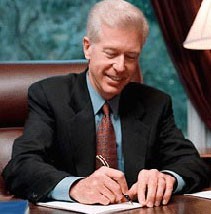
E-Mail California
Governor Gray Davis

*Please Use Paypal Access to Rocketdyne Contamination Hotsheets News
Plaintiffs and their attorneys won a major victory when Gov. Gray Davis signed into law SB688.
The law, which went into effect Jan. 1, rectifies two burdensome procedural laws that have handcuffed plaintiffs' attorneys for years.While one of the two laws, the one which extends the statute of limitations in
personal injury and wrongful death cases, is getting most of the attention, the second will have the most impact on day-to-day litigation.
The law, which includes an amendment to Code of Civil Procedure Section 437(c), extends the summary judgment motion notice period from 28 to 75 days and the response time to summary judgment motions from 14 to 61 days.
It also allows the plaintiffs to file an ex-parte application to request necessary discovery before filing a response. At this point, the summary judgment motion may be continued to allow for this discovery or the motion can be denied outright.
Summary judgment motions have long been used as an effective tool to keep frivolous claims out of the courtroom.
However, in 1992, business and defense counsel lobbyists tilted the scale of justice when they convinced the Legislature to pass amendments to Section 437(c) that affected summary judgment motions.
These 1992 amendments greatly increased the burden on plaintiffs when responding to summary judgment motions but did not increase the response time allotted, which remained at only 14 days. Meanwhile, the moving party had a minimal burden to substantiate its motion.
In the allotted 14 days, plaintiffs were required to provide not only typical opposition papers, including a memorandum of points and authorities, but also a separate statement, responding to each of the material facts contended by the moving party to be undisputed and setting forth any other disputed material facts. Summary judgment motions have become paper wars.
Plaintiffs also were required to reference evidence supporting each material fact contended to be disputed.
Of course, all the evidence had to be gathered, analyzed and submitted to the court within this 14-day period.
This was quite a tall order to fill, especially in only 14 days. Smaller firms and sole practitioners often find themselves outmatched by the big guns hired by defendants, who want nothing more than to inundate the smaller firms with demands for reams of documentation.
Under the old Section 437(c), defense counsel filed eleventh hour motions that required little from the defense but demanded that plaintiffs' counsel undertake the Herculean task of quickly preparing detailed responses that would convince a court of the existence of issues of material fact.
Moving parties have regularly used summary judgment motions to get a case against them thrown out, poison the well and, thus, prejudice the trial judge against the plaintiff and its case or force the plaintiff to quickly pull together its case and then hold the plaintiff to that case even though additional evidence or discovery may be uncovered later.
Unfortunately, trial courts have been only too happy to play along. From the early 1990s onward, the court system in California has been in "court-efficiency" mode.
Judges have, therefore, been desperate to clear their jammed calendars, and summary judgments provide the perfect remedy.
Unfortunately, clearing cases from the calendar using summary judgment motions can sometimes come at the expense of justice. In the long run, all it does is create a backlog in the appellate courts where a barrage of summary judgment motions wait on appeal.
As a result of the new legislation, which gives plaintiffs' attorneys a longer period to prepare a proper response to summary judgment motions, Californians should expect to see fewer such motions granted.
Under this new legislation, plaintiffs now have time to logically and thoroughly argue against the defendants' "statement of undisputed facts" and present persuasive evidence to convince a court the case must move forward.
Defense attorneys and business organizations have been quick to charge that the new law will do nothing more than delay the trial process.
Plaintiffs' attorneys counter that it will prevent legitimate cases from being thrown out.
In reality, the new law means that after 11 years of disparity between defendant and plaintiff, procedural fairness finally has been restored.
*A. Barry Cappello is a trial lawyer and the managing partner of *Cappello & McCann in Santa Barbara. (*Rocketdyne/Boeing Personal Injury and Wrongful Death Attorney and Law Firm)